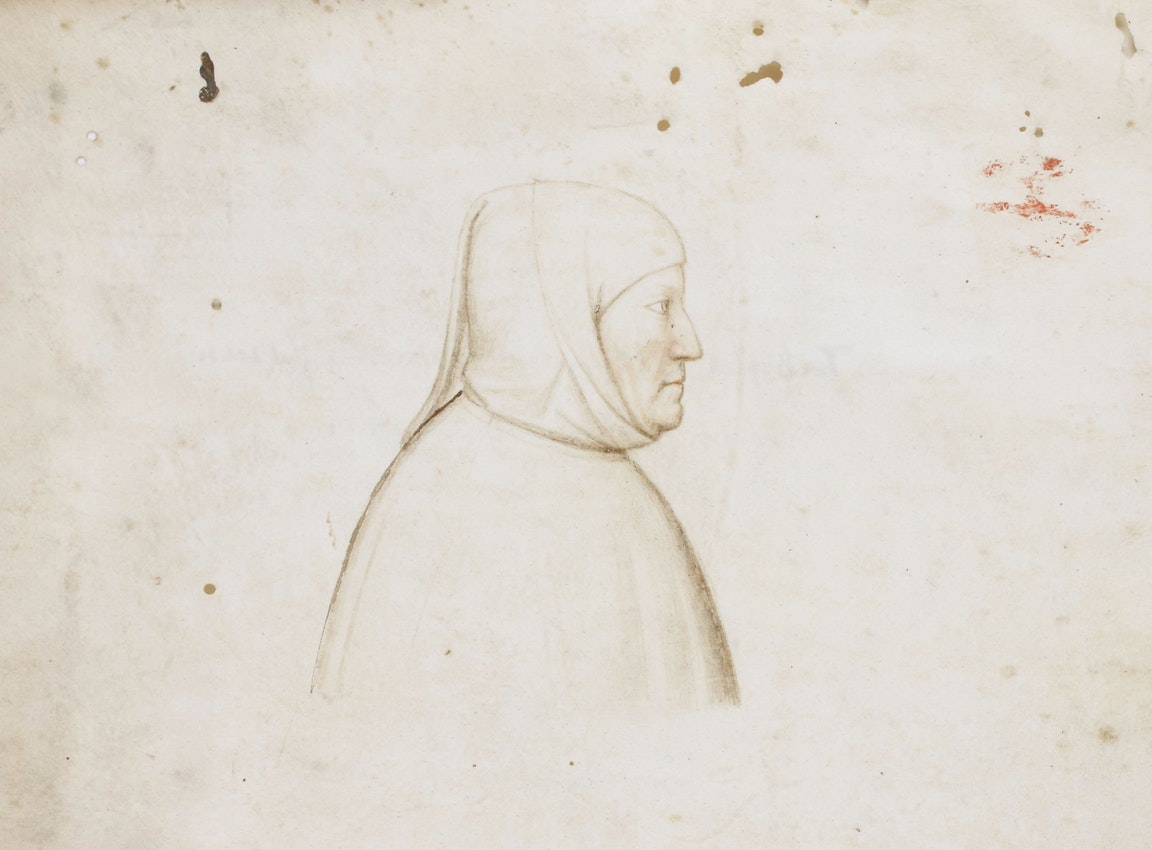
Portrait by Altichiero da Verona of Francesco Petrarch, from a 1379 copy of the latter’s De viris illustribus — Source.
The Italian poet and scholar Francesco Petrarch lived through the most deadly pandemic in recorded history, the Black Death of the 14th century, which saw up to 200 million die from plague across Eurasia and North Africa. Through the unique record of letters and other writings Petrarch left us, Paula Findlen explores how he chronicled, commemorated, and mourned his many loved ones who succumbed, and what he might be able to teach us today.
What will we remember of this year of COVID-19 and how will we recall it? In 1374, during the final year of a long and interesting life, the Italian humanist and poet Francesco Petrarch observed that his society had lived with “this plague, without equal in all the centuries”, for over twenty-five years.1 His fortune and misfortune had been to outlast so many friends and family who perished before him, many of them from this devastating disease.
One of the most eloquent voices of his time, Petrarch spoke on behalf of an entire generation of plague survivors, following the pandemic of 1346–53 and its periodic return. He skillfully wielded his pen to express his society’s collective grief in the most personal and meaningful ways, acknowledging the effect of so much pain and loss. In the immediate aftermath of the particularly devastating year of 1348, when plague engulfed the Italian peninsula, his good friend Giovanni Boccaccio in his Decameron sketched an indelible portrait of young Florentines fleeing their plague-ridden city to wait out the storm by telling one hundred tales. For his part, Petrarch documented the experience of plague over several decades, probing its changing effects on his psyche. The Black Death sharpened his sense of the sweetness and fragility of life in the face of the endemic reality of disease that came in so many different forms. He had big questions and was in search of answers.
“The year of 1348 left us alone and helpless”, Petrarch declared at the very beginning of his Familiar Letters, his great project to share carefully selected versions of correspondence with friends.2 What was the meaning of life after so much death? Had it transformed him, or for that matter anyone, for the better? Could love and friendship survive plague? Petrarch’s questions allowed his readers to explore how they, too, felt about these things. He gave them permission to express such sentiments, indeed took up the burden, which was also his literary opportunity, to articulate the zeitgeist.
Petrarch was famously a self-pofessed wanderer who rarely stayed in one place very long. He alternated between periods of self-imposed isolation in the countryside and full immersion in the life of cities, even during the worst outbreaks of disease. This mobility made him an especially unique observer of how plague became a pandemic. At the end of November 1347, one month after Genoese ships brought plague to Messina, Petrarch was in Genoa. Disease spread rapidly by land and sea — through rats and fleas, though at the time it was believed to be a product of the corruption of the air. Petrarch’s awareness of the course of this pandemic comes through clearly in a letter written from Verona on April 7, 1348, when he refused the invitation of a Florentine relative to return to his native Tuscany, citing “the plague of this year which has trampled and destroyed the entire world, especially along the coast”.3
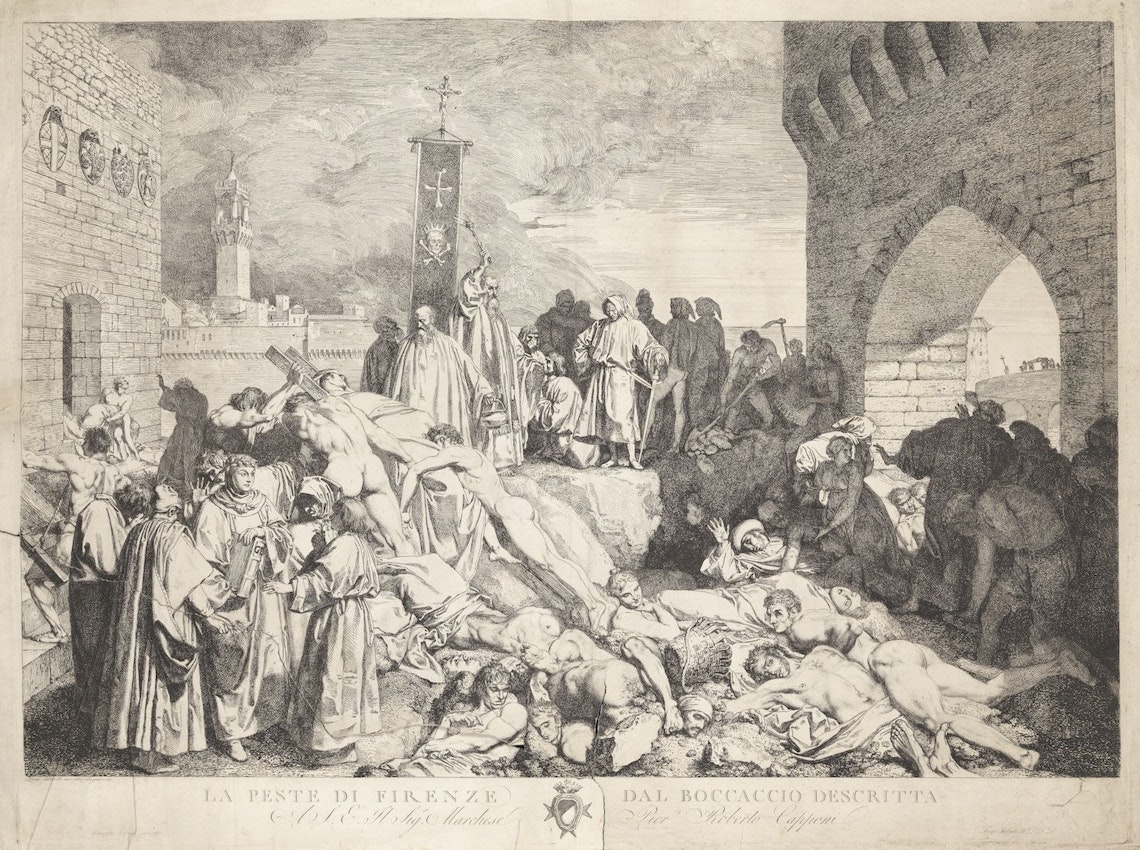
The Plague of Florence as Described by Boccaccio, an etching (ca. early 19th century) by Luigi Sabatelli of a plague-struck Florence in 1348, as described by Petrarch’s friend Giovanni Boccaccio (pictured with a book bearing his initials) — Source.
Returning several days later to Parma, still a plague-free zone, Petrarch learned that his relative the poet Franceschino degli Albizzi, on his way back from France, had died in the Ligurian port of Savona. Petrarch cursed the toll that “this pestilential year” was now exacting.4 He understood that the plague was spreading, yet perhaps this was the first time that the escalating mortality struck close to home. “I had not considered the possibility of his being about to die”.5 Plague now touched him personally.
As the year progressed, Petrarch felt increasingly surrounded by fear, sorrow, and terror. Death came suddenly and repeatedly. In June, a friend who came to dinner was dead by morning, followed by the rest of the family in a matter of days. In the poem “To Himself”, an effort to capture the strangeness of this experience, Petrarch imagined a future that would not understand how awful it had been to be alive in “a city full of funerals” and empty homes.6
Petrarch talked of retreating from the plague-infested cities with his closest friends. After bandits attacked two of them as they traveled from France into Italy, murdering one, nothing came of it. Perhaps the survivors recognized the folly of an idealistic plan that simply did not fit their dispersed circumstances. In July 1348, Petrarch’s most important patron, Cardinal Giovanni Colonna, died of plague, along with many members of this distinguished Roman family whom he served in Avignon. The poet was now out of a job, more restless and unmoored than ever.
Petrarch deeply mourned the “absence of friends”.7 Friendship was his joy and his sorrow. He compensated for this loss by writing eloquent letters to the living as well as rereading his favorite missives to the deceased, preparing the best ones for publication. In an era of almost instantaneous communication via email, phone, and social media, it is easy to forget how important correspondence was as a technology to bridge social distance. Letters, as Petrarch’s ancient Roman hero Cicero famously declared, made the absent present.8
The act of correspondence could also, of course, bring anguish. Petrarch worried about whether friends were still alive if they did not respond quickly. “Free me from these fears as soon as possible by a letter from you”, Petrarch encouraged one of his closest friends, nicknamed Socrates (the Flemish Benedictine monk and cantor Ludwig van Kempen), in September 1348.9 He fretted that “the contagiousness of the recurring plague as well as the unhealthy air” might precipitate another untimely death.10 Communication may not have been swift but it was nonetheless effective and, ultimately, reassuring.

Portrait of Petrarch by Giorgio Visari, 16th century — Source.
At the end of this awful year, Petrarch predicted that anyone who escaped the first assault should prepare for the viciousness of plague’s return. This was an astute and ultimately accurate observation. During the following year, Petrarch continued to enumerate plague victims as well as the cumulative effects of quarantine and depopulation. He wrote a poem commemorating the tragic death of Laura, a woman he had known and loved in southern France, only to discover that the person to which he’d sent the poem, the Tuscan poet Sennuccio del Bene, later died of plague as well, making Petrarch wonder if his words bore the contagion. Another sonnet was required. The act of writing, which had initially been impossibly painful, began to elevate his spirits. Life had become cruel and death unrelenting but he compensated by taking pen in hand — the only useful weapon he had besides prayer and the one he preferred. Others advised flight and proposed temporary public health measures such as quarantine, but Petrarch seems to have felt that he might think and write his way through this pandemic.
Everywhere he traveled, Petrarch observed the absence of people in the cities, the fields that lay fallow in the countryside, the disquiet of this “afflicted and nearly deserted world”.11 By March 1349, he found himself in Padua. He was dining with the bishop one evening when two monks arrived with reports of a plague-ridden French monastery. The prior had shamefully fled and all but one of the thirty-five remaining monks were dead. This was how Petrarch discovered that his younger brother Gherardo, now celebrated for his courage and caring, was the sole survivor of this pestilential holocaust. The hermitage in Méounes-lès-Montrieux, which Petrarch visited in 1347 and wrote about in his work On Religious Leisure still exists today. He immediately wrote Gherardo to express fraternal pride in having a plague hero in the family.
In October 1350, Petrarch moved on to Florence and it was here that he first met Boccaccio. By this time the city was no longer the epicenter of the pandemic, but its effects were still tangible, like a raw wound, or more accurately a lanced yet still pustulating bubo, that had not yet healed. Boccaccio was in the midst of drafting the Decameron. Although there is no record of the two writers discussing how to write about plague, we do know that Boccaccio avidly consumed Petrarch’s poetry and prose, copying lengthy passages in his notebooks at many different moments throughout a long friendship that lasted until their deaths one year apart. It was Petrarch’s early plague writing that spurred Boccaccio to complete his own take on how 1348 became the year their world changed.
Around 1351, Petrarch began to memorialize those whom he loved and lost by inscribing his recollections of them on the pages of a much-treasured possession — his copy of Virgil’s works adorned with a beautiful frontispiece by the Sienese painter Simone Martini. He began this practice of commemoration by recording the death — from three years earlier, in 1348 — of his beloved Laura, the subject of so many of his poems. Petrarch resolved to use every ounce of his eloquence to make her eternally present in his poetry but also in his Virgil. On its flyleaf, he inscribed these unforgettable words: “I decided to write down the harsh memory of this painful loss, and I did so, I suppose, with a certain bitter sweetness, in the very place that so often passes before my eyes”. He did not want to forget the searing pain of this moment that awakened his soul and sharpened his consciousness of the passage of time. Boccaccio was among Petrarch’s friends who wondered if Laura ever existed outside of his poetic imagination, but he never questioned Petrarch’s determination to remember that year as transformative.
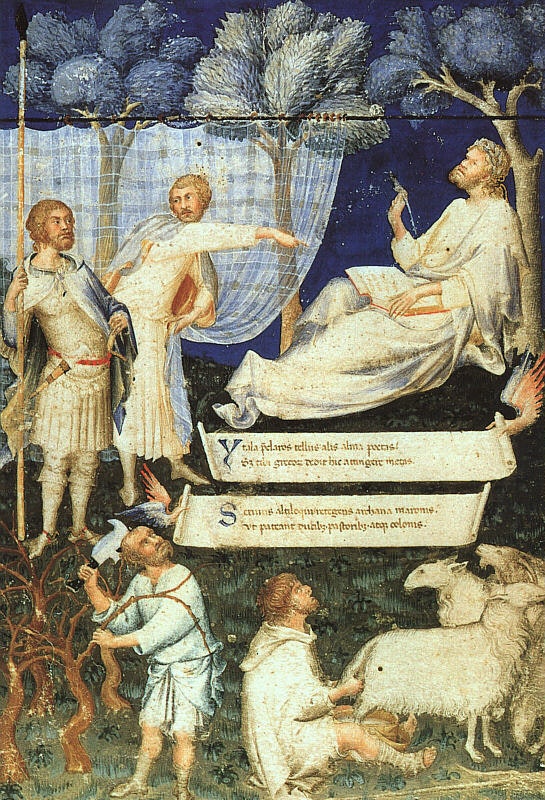
Simone Martini’s frontispiece for Petrarch’s copy of Virgil — Source.
-edit.jpg?fit=max&w=1200&h=850)
Wenceslaus Hollar’s imagining of Laura, 1650 — Source.
Among the other inscriptions in Petrarch’s Virgil — now held by the Ambrosian Library in Milan — is notice of the death of his twenty-four-year-old son Giovanni on July 10, 1361 in Milan, “in that publicly ruinous though unusual outbreak of plague, one that found and fell upon that city, which up to that point had been immune to such evils”. Spared the devastation of the first wave of plague, Milan — where Petrarch had been living since 1353 — became the focal point of a second pandemic in 1359–63. By 1361, Petrarch had left for Padua, but his son stubbornly chose to remain behind.
In 1361, following his son’s death, Petrarch once again took up his pen. He began his Letters of Old Age, as he called his second collection of correspondence, with a letter to a Florentine friend Francesco Nelli bemoaning the loss of his beloved friend Socrates in that year. Socrates had been the person who informed Petrarch of Laura’s passing, and Petrarch added a note in his copy of Virgil about this latest plague death to pierce his heart. In his Letters of Old Age, he wrote: “I had complained that the year 1348 of our era had deprived me of nearly every consolation in life because of my friends’ deaths. Now what shall I do in the sixty-first year of this century?”12 Petrarch observed that the second pandemic was worse, nearly emptying out Milan and many other cities. He was now determined to write in a different voice, no longer lamenting but actively combatting fortune’s adversity.
During this second pandemic, Petrarch launched a fierce critique of the role that astrologers played in explaining plague’s return and predicting its course. He considered their self-proclaimed truths to be largely accidental: “Why do you feign futile prophecies after the fact or call chance truths?”13 He chastised friends and patrons who revisited their horoscopes, considering them a false science predicated on the misuse of astronomical data.
As plague spread through the urban centres, a physician friend encouraged the poet to flee to the country air of Lake Maggiore, but Petrarch refused to succumb to terror. Remaining in cities, he began to spend the bulk of his time between Padua and Venice. When plague reached the Venetian Republic, friends renewed their entreaties, leading Petrarch to comment: “it has very often happened that a flight from death is a flight to death”.14 Boccaccio came to visit and decided not to tell him of their mutual friend Nelli’s demise, leaving Petrarch to discover his most recent loss when letters returned, unopened.
Plague returned to Florence with a vengeance in the summer of 1363. In this heightened atmosphere of renewed anxiety, Petrarch redoubled his criticisms of astrologers who deluded the living with predictions of when the latest pandemic would end. An anxious populace hung on their every word. “We do not know what is happening in the heavens”, he fumed in a letter to Boccaccio in September, “but impudently and rashly they profess to know”.15 A pandemic was a business opportunity for astrologers who peddled their words to “parched minds and thirsty ears”.16 Petrarch was hardly alone in pointing out that the astrologers’ conclusions had no basis in astronomical data or the spread of disease. They sold false hope and certainty in the marketplace. Petrarch longed for a more reasoned response to pandemic with better tools than the science of the stars.

Death pays an astrologer a visit, in Hans Holbein’s Dance of Death series, 1523–5 — Source.
What then of medicine? Petrarch was famously skeptical about physicians who claimed too much certainty and authority. He believed that physicians, like everyone else, needed to acknowledge their own ignorance as a first step towards knowing anything. Ignorance itself was “pestiferous” — a disease to be rooted out and eradicated even if there was no vaccine.17 While professing great respect for the art of healing, he had no patience with what he slyly dubbed “pestilential incompetence” in his Invectives against the Physician.18 Plague alone did not reveal medicine’s failure but it brought its limits into stark relief.
Petrarch befriended some of the most famous physicians of his age and stubbornly debated their advice regarding his own health as he aged. “When today I see young and healthy doctors falling ill and dying everywhere, what do you tell others to hope for?”19 Petrarch expressed this sentiment in a letter to the famous Paduan physician and inventor Giovanni Dondi upon hearing of the premature death of the Florentine physician Tommaso del Garbo in 1370. Del Garbo wrote one of the most important plague treatises of the fourteenth century, dedicated to preserving the health and well-being his fellow Florentines after his experience of the first pandemic. Ultimately, he succumbed to this disease.
In the end, physicians were as human as anyone else; their learning did not confer any greater immortality on them or their patients. Petrarch continued to live, following some but not all of the medical advice he received, especially for the discomforts of scabies, a skin ailment he described as quite the opposite of “a brief and fatal illness” such as plague — “I am afraid that it is a long and tiring one”.20 Although he did not believe that medicine had any special powers of salvation, he respected the combination of learning, experience, caring, and humility that were the hallmarks of the best medical practitioners. Like his brother Gherardo, who cared with faith rather than medicine, and unlike the astrologers, who manipulated data to fulfill their prognostications, good honest doctors were also his plague heroes.
Writing from Venice in December 1363, Petrarch noted some flattening of the curve where he was but did not think the plague had ended elsewhere. “Still it rages widely and horribly” he wrote.21 Offering a vivid portrait of a city unable to bury its dead or properly mourn, he observed the latest tragedy but no longer openly grieved. It seems he was learning to live with plague.
In 1366, Petrarch brought to conclusion his Remedies for Fortune Fair and Foul, which included a dialogue about plague. “I dread the plague”, proclaims Fear, ventriloquizing the escalating anxiety about this “omnipresent danger”.22 Petrarch’s Reason pragmatically observed that fear of plague is “nothing but a fear of death”.23 In a moment of dark humor, he joked that it was better to die in so much good company during a pandemic than to die alone. As for the survivors, Petrarch could not resist pointing out how many of them were undeserving of their good fortune. The good perished while “this vermin, so hardy that no plague, not death itself can exterminate them”,24 endured. No one said plague meted out death with any justice.

The Triumph of Death fresco by an unknown artist, in the Regional Gallery of Palazzo Abatellis in Palermo, Sicily, ca. 1446 — Source.
A year later, in 1367, Petrarch returned to Verona – the place where he’d joyfully rediscovered Cicero’s lost letters in a monastic library in happier times, and where he’d heard of Laura’s death, so many years ago. The city had suffered greatly during the second pandemic but there were signs of revival underway. Nonetheless, he could not say in all honesty that Verona, or indeed any city that he knew, was as magnificent and prosperous as it had been before 1348. The medieval Italian communes were economic powerhouses whose business dealings traversed the entirety of Eurasia but this prosperity was imperiled. Once again, he found himself thinking about how his world had changed — and not only because of plague. War, politics, the decline of commerce, the sorry state of the church, earthquakes, bitterly cold winters, and general lawlessness were also to blame. He saw the late medieval economy contract, observing the rippling effects far beyond his own world. As he wrote in a letter reflecting on the twenty years since the 1348 outbreak, “I shall admit that I know not what is happening among the Indians and Chinese, but Egypt and Syria and all of Asia Minor show no more increase in wealth and no better lot than we do”.25
Petrarch knew that “plague” was a word of great antiquity, but he considered the experience of “a universal plague that was to empty the world” to be new and unheralded.26 He also understood that plague “really does not disappear anywhere”.27 It had been a twenty-year scourge. He composed this anniversary letter for one of his few remaining childhood friends, Guido Sette, who was archbishop of Genoa. By the time the courier reached Genoa, Sette was no longer alive to read his words. Once again, Petrarch’s pen seemed to foretell the end of another of life’s chapters.
In the spring and summer of 1371, plague returned to the Venetian Republic. Petrarch rebuffed further invitations to escape the maelstrom. He acknowledged how dangerous the cities had become again, in the “jaws of a plague, raging far and wide”, but he had found “a very pleasant, healthful place” from which he would not budge.28 By then Petrarch had retired to the house he built in the picturesque hill town of Arquà (today known as Arquà Petrarca, not far from the COVID-19 hotspot of the Veneto), just south of Padua. Even the impending approach of war did not deter his resolve to remain in the home where he spent his remaining years with family, writing letters to friends and perfecting his collection of poems, nominally in honor of Laura’s memory but also about the nature of time and mortality.

Detail from a fresco showing Petrarch in his study, attributed to either Altichiero da Zevio or Jacopo Avanzi and painted (shortly after Petrarch’s death in 1374) as part of the original “Hall of the Giants” at Padua’s Palazzo dei Carraresi (now in Palazzo Liviano) — Source.
In this bucolic setting, Petrarch continued to receive unhappy news from plague-ridden Italy. Another childhood friend, the papal legate Philippe de Cabassoles, passed shortly after they exchanged letters reaffirming the power of their lengthy friendship. Petrarch once again recorded this loss in the pages of his Virgil. In October 1372, he wrote a letter to his physician friend Dondi consoling him on “sickness and deaths in your family”.29
Petrarch never explained what finally led him to acknowledge in 1373 that he had read his dear friend Boccaccio’s Decameron (completed twenty years earlier). He claimed that a copy mysteriously arrived at his doorstep, yet it seems impossible to believe that he had not known this work until then. Petrarch declared that he skimmed rather than imbibed the Decameron: “If I were to say I have read it, I would be lying, since it is very big, having been written for the common herd and in prose”.30 No one should believe this disingenuous dismissal of the defining book of his generation. It was a joke between two great writers.
Petrarch forgave the author’s moral lapses in the most salacious tales because he appreciated the seriousness of its message, about how human failings — greed, lust, arrogance, and the corruption of church and state — helped to incubate a pestilential world. He especially praised the book’s beginning, admiring the magnificent perfection of Boccaccio’s vivid description of Florence under siege during “that plague-ridden time”. Petrarch paid his friend the ultimate compliment by translating the final tale (regarding the patience and fortitude of a young peasant woman named Griselda married to an arrogant nobleman who tested her in every possible way) from Tuscan into Latin to make it more widely available to readers unfamiliar with the author’s native language. “I have told your story in my own words”.31 Yet in some sense, Petrarch had been doing this ever since 1348 by collecting his own plague tales, finding different ways to express the full spectrum of emotions that this disease evoked.

Illustration from a lavishly illustrated late 15th-century copy of Boccaccio’s Decameron — Source.
When plague returned in 1374 to Bologna (where Petrarch had studied in his youth), he encouraged his friend Pietro da Moglio to flee and join him in Arquà. The famous rhetoric professor declined, citing Petrarch himself as his inspiration to remain in place. In response, Petrarch observed:
“Many are fleeing, everyone is fearful, you are neither – splendid, magnificent! For what is more foolish than to fear what you cannot avoid by any strategy, and what you aggravate by fearing? What is more useless than to flee what will always confront you wherever you may flee?”32
Nonetheless, he wished for his friend’s companionship in the “wholesome air” of Arquà, without promising that it would remain a sanctuary.33 Echoing the predominant understanding of plague as an illness spread by the corruption of the elements that produced miasmas of disease, Petrarch remarked that air was “a treacherous, unstable element”.34
Petrarch died in July 1374, but not of plague, having finally succumbed to various ailments that tormented him in his final years. In his will he left 50 gold florins to his physician friend Dondi for the purchase of “a small finger-ring to be worn in my memory”,35 and 50 florins to Boccaccio “for a winter coat for his studies and night-time scholarly work”.36 Boccaccio would outlive his friend by little more than a year, passing away in December 1375, probably from heart and liver failure.
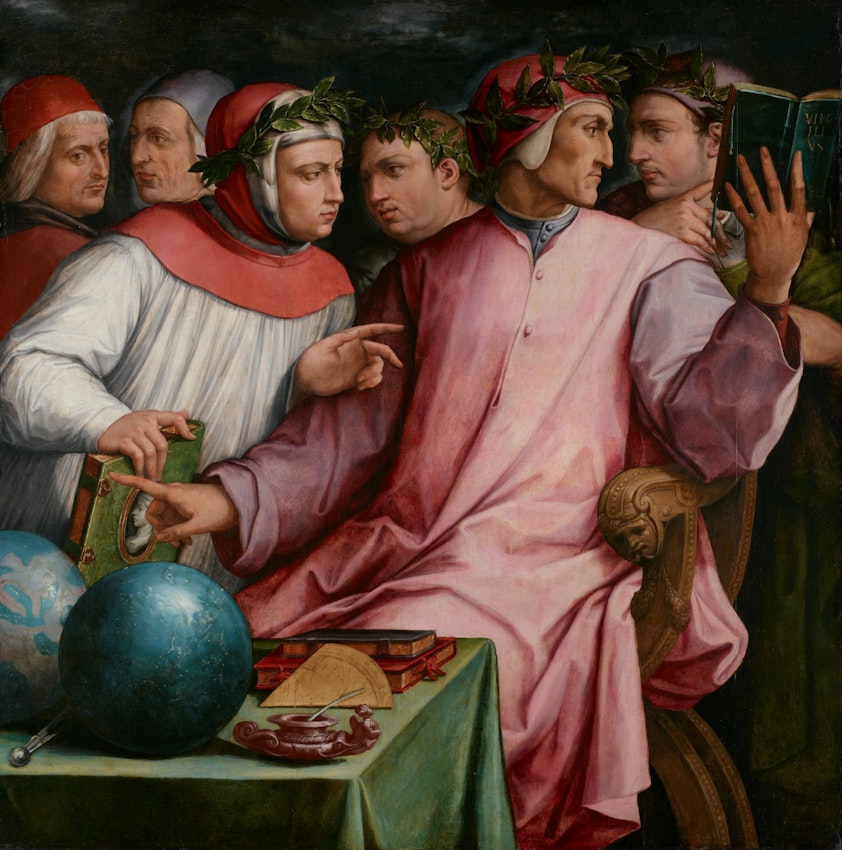
Six Tuscan Poets by Giorgio Vasari, 1554. To the left of a seated Dante is Petrarch in clerical garb and holding a copy of his own Il Canzoniere with a cameo of Laura on its cover. Between Petrarch and Dante can be seen the head of Boccaccio, the other three being Cino da Pistoia, Guittone d’Arezzo and Guido Cavalcanti — Source.
Petrarch’s writings — in both form and content — would go on to greatly influence fifteenth and sixteenth-century Italian literature, history, and philosophy, and the Italian Renaissance in general (indeed some have described him as the “father of the Renaissance” for articulating so eloquently why antiquity mattered for his own times). Today, in the midst of a pandemic, it is his engagement around the effects of plague which resonates most acutely, as may also have occurred during other disease-ridden periods since the fourteenth century, when readers rediscovered Petrarch’s plague letters, dialogue, and poetry. Revisiting Petrarch in these months has made me wonder how we will remember 2020, a year in which disease once again connects many different parts of the world. Our family and friends do indeed create a strangely personal landscape of pandemic but we also bear witness to the larger forces at work that created our moment. Who will write its story?
Fourteenth-century Italy was the first society to document in great detail the experience of a disease that transformed their world. By contrast, Thucydides’ description of the Athens plague in 430 BCE takes up only one chilling passage. Petrarch allows us to see not just what but also how people thought about disease. He astutely recognized the importance of having this public conversation, and through his dedication to recording his reflections, and eliciting them from others, he left a rich documentary record that we can still benefit from today. I find myself wondering about the nature of the record we’ll leave behind of this time. Our archives, though they’ll no doubt be extensive, are unlikely to capture how we interact and communicate with each other in private, on Zoom for example, the way that Petrarch’s letters managed to do.
Some things, of course, we do better today. In general, we resist disease better than people did in Petrarch’s time — the direct result of better diet, sanitary living conditions, modern hygiene and medical innovation. Nonetheless, the uneven experience of COVID-19 has exposed persistent vulnerabilities that we ignore at our peril. The cruelty of the disease has been to strike certain places, certain families, particular groups of friends and communities, and the medical profession caring for them especially hard. We need to learn how to handle this kind of sudden loss. We need to come to terms with its differential impact on all of us. And we should probably be prepared for more. Petrarch might observe that the premodern experience of disease has never entirely gone away.
So many people whom Petrarch knew well, who defined the inner fabric of his world, died in successive waves of plague. An awareness of human mortality was hardwired into his consciousness in a way that it is not for most living today — at least those privileged to enjoy relative health and prosperity, and a life free of all but the minimum of violence, which, of course, is not true for all. Petrarch used his considerable literary talents to capture the essence of this experience. His understanding of the value of love and friendship intensified because of plague, becoming richer and deeper because everything was so imperiled. The dead did not vanish as long as he kept them alive. In a far more personal and affecting way than his friend Boccaccio, he transformed the losses that plague inflicted indiscriminately on friends and family into works of art that still inspire. Had he lived through the AIDS crisis, Petrarch would have understood why a generation responded by making art, film, poetry, and novels as an expression of their pain and anger, and to ensure that the dead were not forgotten.
There is a moral resiliency to his message worth remembering as the first wave of COVID-19 subsides. Petrarch never once offered any reassurances that things would get better. Instead, he responded creatively and thoughtfully to unexpected challenges, assuming that they would end neither quickly nor easily. His words, echoing across a chasm of more than six hundred years, continue to seek an audience. Amidst our own anxieties about what the future might hold, his is a voice from the past, speaking to posterity, challenging us to be creative in our own response to a time of pandemic.
—
This article / Petrarch’s Plague Love, Death, and Friendship in a Time of Pandemic was originally published in The Public Domain Review under a Creative Commons Attribution-ShareAlike 3.0.
—
***
You may also like these posts on The Good Men Project:
 White Fragility: Talking to White People About Racism White Fragility: Talking to White People About Racism |
 Escape the “Act Like a Man” Box Escape the “Act Like a Man” Box |
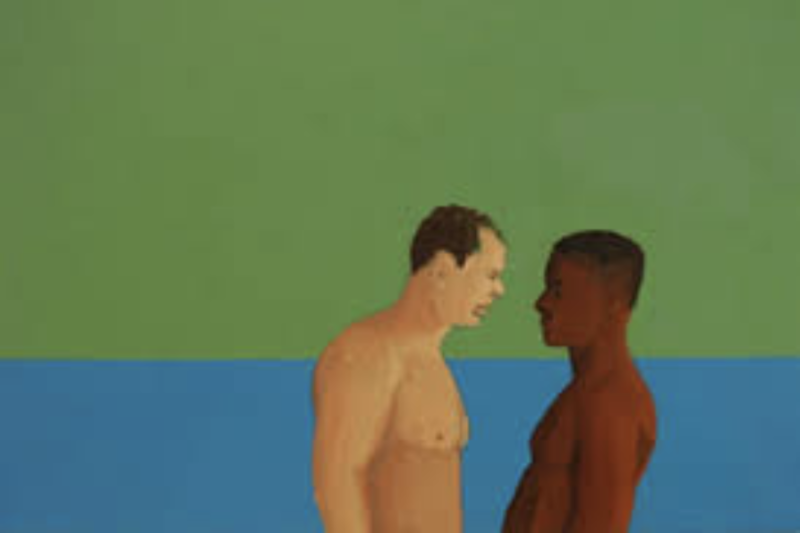 Why I Don’t Want to Talk About Race Why I Don’t Want to Talk About Race |
 What We Talk About When We Talk About Men What We Talk About When We Talk About Men |
Join The Good Men Project as a Premium Member today.
All Premium Members get to view The Good Men Project with NO ADS.
A $50 annual membership gives you an all access pass. You can be a part of every call, group, class and community.
A $25 annual membership gives you access to one class, one Social Interest group and our online communities.
A $12 annual membership gives you access to our Friday calls with the publisher, our online community.
Register New Account
Log in if you wish to renew an existing subscription.
Need more info? A complete list of benefits is here.
The post Petrarch’s Plague Love, Death, and Friendship in a Time of Pandemic appeared first on The Good Men Project.
